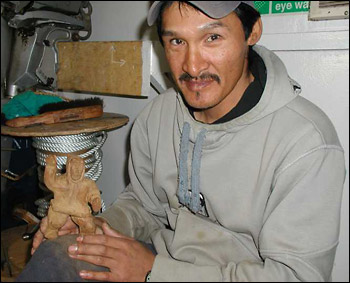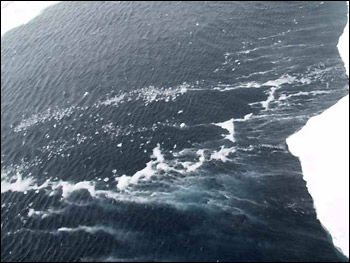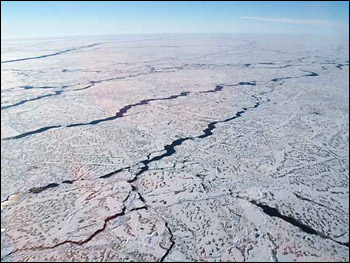Please note: You are viewing
the unstyled version of this website. Either your browser does not support CSS
(cascading style sheets) or it has been disabled. Skip
navigation.
Jennifer Hutchings, IARCSeptember 3, 2006
The weather prevented us from working on the ice, however most other science continues unabated. Joe Illasiak is up on “monkey’s island”, above the ship’s bridge, with his back to the wind, scanning for polar bears. Joe tells me that polar bears like to hunt in this weather, and will walk upwind using the advantage the wind brings to sniff out their prey. Their prey is mainly seals, as those are plentiful. Although we have not seen seals for a while, they must be in the area. We have been going through a large region of ice that has ice algae growing on its base. At this time of year the algae forms long brown strands under the ice. There is a unique ecosystem that takes advantage of the protection in the brine channeled structure of the ice base. Polar bears fatten up for the fast approaching winter on the seals that feed on anthropods that graze on the microscopic contents of the algae community. As the CTD Rosette is lowered into the deep ocean, the CTD watch members see the effects of the weather. The ship was drifting with the ice at 1.5 knots. This was fast enough to stream the rosette cable out at a shallow angle to the ship, making the cold work of watching the line descend into the ocean even more important than usual. The bad weather is in fact the front of a low pressure system moving over us from the west. This system is deep, bringing warm (around 0 °C or 32 °F) moist air from the south. Hence the strong winds and heavy snow fall. Low pressure systems have slightly divergent winds circling them. This is because frictional effects act to move the wind direction towards the higher pressure on the outskirts of the weather system. The movement of this weather system is having dramatic effects on the ice pack. At the end of summer, and after predominantly northerly winds for many weeks, the ice is pushed into a close pack to the northern Beaufort Sea, which is where we are now. The weather system is moving across this ice, and as the ice is unconfined by surrounding land, it moves mainly in response to the storm. As the pack ice is blown apart by the divergent winds, the pack cracks, and cracks grow into leads. We see a huge lead open up around the ship, large enough for the ship to navigate through. As the lead grows fast and the weather system is moving fast across the region, the pack ice moves fast in response. We are certainly privileged to watch this dramatic event from the cozy and stable Louis S. St. Laurent! Last updated: October 7, 2019 | |||||||||||||||||||
Copyright ©2007 Woods Hole Oceanographic Institution, All Rights Reserved, Privacy Policy. | |||||||||||||||||||





